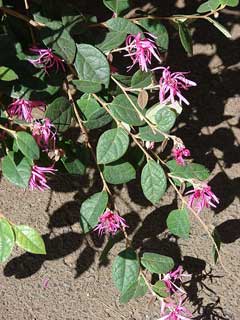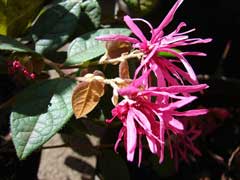 |
|
http://www.hear.org/starr/ |
 |
| http://www.hear.org/starr/ |
Translate this page:
Summary
Bloom Color: Pink. Main Bloom Time: Early spring, Late spring, Mid spring. Form: Spreading or horizontal, Upright or erect, Vase.
Physical Characteristics

 loropetalum chinense is an evergreen Tree growing to 2 m (6ft) by 1.2 m (4ft in) at a slow rate.
loropetalum chinense is an evergreen Tree growing to 2 m (6ft) by 1.2 m (4ft in) at a slow rate.
See above for USDA hardiness. It is hardy to UK zone 9. It is in leaf all year, in flower from February to April, and the seeds ripen from May to July. The species is hermaphrodite (has both male and female organs).
Suitable for: light (sandy), medium (loamy) and heavy (clay) soils. Suitable pH: mildly acid and neutral soils. It can grow in semi-shade (light woodland) or no shade. It prefers moist soil.
UK Hardiness Map
US Hardiness Map
Synonyms
L. indicum. Hamamelis chinensis.
Plant Habitats
Woodland Garden Sunny Edge;
Edible Uses
References More on Edible Uses
Medicinal Uses
Plants For A Future can not take any responsibility for any adverse effects from the use of plants. Always seek advice from a professional before using a plant medicinally.
Depurative Dysentery Haemostatic Pectoral
The whole plant is depurative, haemostatic and pectoral[147]. A decoction is used in the treatment of coughing in tuberculosis, dysentery, enteritis etc[147, 218]. The leaves can be crushed and pulverised for external application on wounds[147].
References More on Medicinal Uses
The Bookshop: Edible Plant Books
Our Latest books on Perennial Plants For Food Forests and Permaculture Gardens in paperback or digital formats.

Edible Tropical Plants
Food Forest Plants for Hotter Conditions: 250+ Plants For Tropical Food Forests & Permaculture Gardens.
More

Edible Temperate Plants
Plants for Your Food Forest: 500 Plants for Temperate Food Forests & Permaculture Gardens.
More

More Books
PFAF have eight books available in paperback and digital formats. Browse the shop for more information.
Shop Now
Other Uses
References More on Other Uses
Cultivation details
Landscape Uses:Border, Screen, Standard, Superior hedge, Specimen. Requires a rich well-drained neutral to acid soil in full sun or light shade[188]. Requires a lime-free humus-rich soil[182]. One report says that it succeeds on a sheltered north wall[182] whilst another says that it needs a sunny position[219] and another says it needs warm summers[260]. Prefers a cool root run[182]. This species is not very cold-hardy in Britain, it is also slow growing[184]. It succeeds outdoors in the mildest areas of the country, tolerating temperatures down to about -5°c[184]. Plants do not flower well if the temperature drops below 5°c[200]. The Japanese form of this species might be hardier[11]. Plants grow taller in their native habitat, reaching a height of 3 metres[200]. The flowers emit a delicate sweet perfume[245]. Some named forms have been developed in Japan for their ornamental value[182]. Special Features:
Attractive foliage, Not North American native, Fragrant flowers, Attractive flowers or blooms.
References Carbon Farming Information and Carbon Sequestration Information
Temperature Converter
Type a value in the Celsius field to convert the value to Fahrenheit:
Fahrenheit:
The PFAF Bookshop
Plants For A Future have a number of books available in paperback and digital form. Book titles include Edible Plants, Edible Perennials, Edible Trees,Edible Shrubs, Woodland Gardening, and Temperate Food Forest Plants. Our new book is Food Forest Plants For Hotter Conditions (Tropical and Sub-Tropical).
Shop Now
Plant Propagation
Seed - sow in a warm greenhouse in late winter or early spring[188]. When they are large enough to handle, prick the seedlings out into individual pots and grow them on in the greenhouse for at least their first winter. Plant them out into their permanent positions in late spring or early summer, after the last expected frosts. Give the plants some protection from the cold for at least their first winter outdoors. Cuttings of half-ripe wood, 5 - 8cm with a heel, July/August in a frame[200]. Fair to good percentage[78]. Layering in the spring[188].
Other Names
If available other names are mentioned here
Native Plant Search
Search over 900 plants ideal for food forests and permaculture gardens. Filter to search native plants to your area. The plants selected are the plants in our book 'Plants For Your Food Forest: 500 Plants for Temperate Food Forests and Permaculture Gardens, as well as plants chosen for our forthcoming related books for Tropical/Hot Wet Climates and Mediterranean/Hot Dry Climates. Native Plant Search
Found In
Countries where the plant has been found are listed here if the information is available
Weed Potential
Right plant wrong place. We are currently updating this section.
Please note that a plant may be invasive in one area but may not in your area so it’s worth checking.
Conservation Status
IUCN Red List of Threatened Plants Status :

Growth: S = slow M = medium F = fast. Soil: L = light (sandy) M = medium H = heavy (clay). pH: A = acid N = neutral B = basic (alkaline). Shade: F = full shade S = semi-shade N = no shade. Moisture: D = dry M = Moist We = wet Wa = water.

Expert comment
Author
(R.Br.)Oliv.
Botanical References
11200266
Links / References
For a list of references used on this page please go here
Readers comment